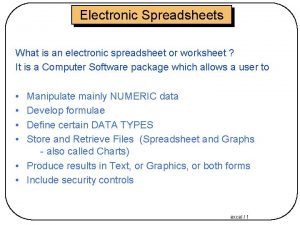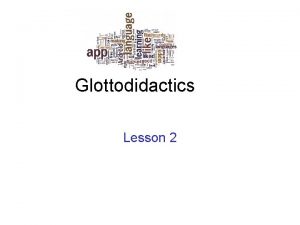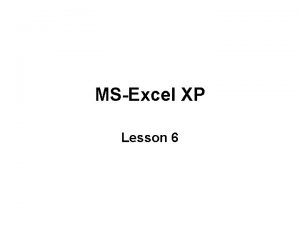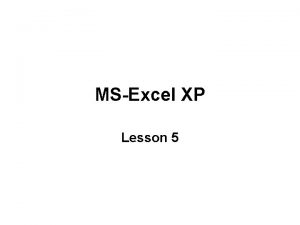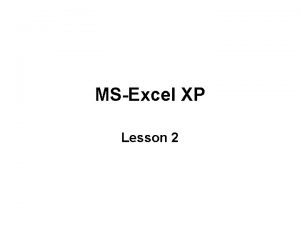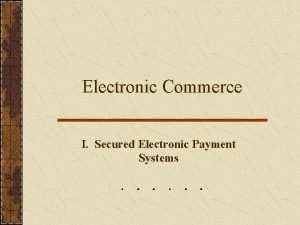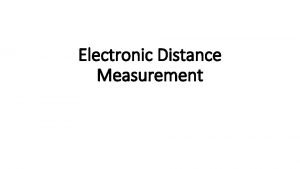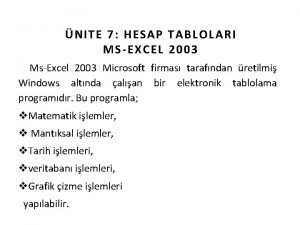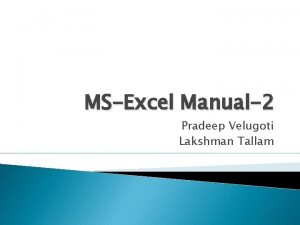MSExcel XP Lesson 1 Introduction to MSExcel Electronic


















- Slides: 18

MS-Excel XP Lesson 1

Introduction to MS-Excel • • • Electronic Spreadsheet Software Application Spreadsheet consists of rows and columns Spreadsheet named as worksheet in excel Workbook is a file of an excel (*. xls) Workbook consists of many worksheets Advantages – Creating business models • • • Chase budgets Profit and loss Forecasts Sales Plans Expenditure

Opening MS-Excel 1. Method 1 1. 2. 3. 4. Click on start button in task bar Select all programs Select Microsoft office Click on Microsoft Office Excel 2. Method 2 1. 2. 3. 4. Click on start button Click on run Type excel Click on ok 3. Method 3 1. Double click on MS-Excel shortcut on desktop

Creating shortcut to MS-Excel 1. 2. 3. 4. 5. Right click on desktop Select new sub menu Click on shortcut menu item Click browse button’ Select c: program filesmicrosoft officeoffice 11excel. exe and click ok 6. Click on next 7. Type shortcut as MS-Excel 8. Click on finish button

MS-Excel XP interface Title bar Menu bar Standard & Formatting tool bar Formula Bar Column Heading Cell Pointer Task Pane Worksheet area Row Heading Cell Vertical Scroll Bar Worksheet grid lines Worksheet tabs Horizontal Scroll Bar Status bar

MS-Excel XP interface 1. Columns are named A, B, C, …. , AA, BA, …, 2. Column heading: Column character 3. 256 columns (A to IV) 2. Rows 1. Rows are numbered from 1 to 65536 2. Row heading: Row number 3. Cell 1. 2. 3. 4. 5. Intersecting point of a row and columns Rectangular area in which you enter data Cells are identified using cell address Cell address: Column character, Row number Final cell address: IV 65536

MS-Excel XP interface 1. Cell reference 1. Each cell has a unique address 2. Cell reference: Cell address 3. Cell address: Column character, Row number (A 1) 2. Cell Pointer 1. Dark rectangle that highlights the cell you are working in 2. Current active cell 3. Formula Bar: Name Box+ Formula Area 4. Name Box 1. Display active cell address 5. Formula Area 1. Enter or edit data in the worksheet

MS-Excel XP interface 1. Range 1. One or more cells 2. If all the cells in the range are consecutive (adjoining) you can refer to the range by typing first and last cell addresses, separating each with a colon. 3. For example if your range includes the cells A 1, A 2, A 3, , B 1, B 2, B 3 you can name range as A 1: B 3 2. Fill handle Fill Handle

MS-Excel XP interface 1. 2. Worksheet The primary document use in MS-Excel to store and work with data. A worksheet consists of cells organized into columns and rows and is always part of a workbook. Also called Spreadsheet. There are 256 columns and 65536 rows in a worksheet. Workbook In MS-Excel, a workbook is the file in which you work and store your data. Because each workbook can contain many worksheets, you can organize various kinds of related information in a single file. Use worksheets simultaneously and perform calculations based on data from multiple worksheets. The names of the sheets appear on the tabs at the bottom of the workbook window. To move from sheet to sheet, click the sheet tabs. The name of the active sheet is bold.

Adding or Removing a Tool Bar 1. 2. 3. 4. Open MS-Excel Click on view menu Select tool bars sub menu Select a tool bar to add or cancel a tool bar to remove in check box menu items Adding or Removing a Task Pane 1. Open MS-Excel 2. Click on view menu 3. Select a task pane to add or cancel a task pane to remove in check box menu item (Ctrl+F 1)

Adding or Removing a Formula Bar 1. Open MS-Excel 2. Click on view menu 3. Select formula bar check box for adding and cancel formula bar check box for removing a formula bar Adding or Removing a Status Bar 1. Open MS-Excel 2. Click on view menu 3. Select status bar check box for adding and cancel status bar check box for removing a status bar

Opening a New Workbook 1. Click on file menu 2. Click on new menu item 3. Click on blank workbook option in new workbook task pane 4. MS-Excel file – Workbook 5. You can use new button in standard tool bar to opening a new workbook 6. Shortcut to opening a new workbook is Ctrl+N

Saving a Workbook 1. Click on file menu 2. Click on save menu item 3. Browse the location and create the new folder (optional) and type a workbook name and click on save button in save as dialog box. Workbook extension of excel is. xls

Saving a Workbook in Another Location 1. Click on file menu 2. Click on save as menu item 3. Browse the location and create the new folder (optional) and type a workbook name and click on save button in save as dialog box. Save- Initial save location Save As- Save the workbook to new location or giving another workbook name

Opening a Workbook 1. 2. 3. 4. Open excel Click file menu Click open menu item Browse and select the file and click on open button in Open dialog box 5. You can use open button in standard tool bar 6. Shortcut to opening a workbook is Ctrl+O

Closing a File 1. Click on file menu 2. Click on close menu item 3. You can use close button in menu bar Exiting from Excel 1. Click on file menu 2. Click on exit menu item 3. You can use close button in title bar

Moving around the Worksheet 1. 2. 3. 4. 5. 6. 7. 8. 9. Using mouse Using keyboard Arrow keys Alt+ Page up, Alt+ Page down Page up, Page down Ctrl+ Home, Ctrl+ Down arrow key End+ Right arrow key Ctrl+ Right arrow key End+ Down arrow key

Entering Data 1. The information or data you enter in a cell can be 1. 2. 3. 2. Text 1. 3. Entries can include only the digits 0 to 9 and any of the special characters, +, -, * so on Formula 1. 5. Entries can contain a combination of letters, numbers and any other special characters. Number 1. 4. Text Number Formula Entries perform calculations using numbers or data contained in other cells Text will appear in the left hand corner of the cell and numbers will appear in the right hand corner of the cell
 An electronic is the electronic exchange of money or scrip
An electronic is the electronic exchange of money or scrip Electronic news gathering and electronic field production
Electronic news gathering and electronic field production Electronic spreadsheets?
Electronic spreadsheets? Lesson outline lesson 3 describing circuits answers
Lesson outline lesson 3 describing circuits answers Lesson outline lesson 3 mountain building answers
Lesson outline lesson 3 mountain building answers Lesson outline lesson 2 aquatic ecosystems answer key
Lesson outline lesson 2 aquatic ecosystems answer key Micro lesson ideas
Micro lesson ideas Ihi l101
Ihi l101 Where did ravi hide the kitten?
Where did ravi hide the kitten? Chapter 1 lesson 1 your total health
Chapter 1 lesson 1 your total health Weather forecasts lesson 3 outline answers
Weather forecasts lesson 3 outline answers Sat vocabulary lesson 4
Sat vocabulary lesson 4 Physical properties lesson 2
Physical properties lesson 2 Lesson 1 thermal energy and the behavior of matter
Lesson 1 thermal energy and the behavior of matter Unit 6 lesson 1 climates of the world
Unit 6 lesson 1 climates of the world Glottodidactics
Glottodidactics Measurement and scientific tools lesson 2
Measurement and scientific tools lesson 2 Characteristic of fingerprint
Characteristic of fingerprint Unit 1 lesson 1
Unit 1 lesson 1


